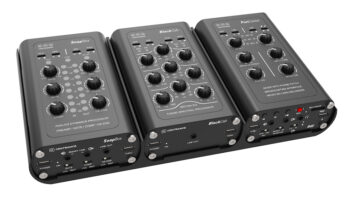
For many centuries, the kingdom of Dynamica’s three nation-states, Softius, Moderatium, and Loudius, lived in harmony. Little did the ruler of Dynamica know that his former apprentice, Loudius Maximus, was scheming to rule the entire kingdom. Armed with powerful weapons never seen before—like the feared Maximizer Rex—Loudius Maximus crushed the outnumbered armies of Dynamica in what is now called the Loudness Wars.
Historians note that the Loudness Wars ended in the early 21st century with the adoption of certain LUFS standards by streaming services. It was a step in the right direction…after which, some took a step in the wrong direction. In theory, when music is brought to the same LUFS level, the perceived volume is the same. So, regardless of what streaming service you listen to, your 1990 hardcore Belgian techno mastered at -5 LUFS will have the same perceived level as a jazz quartet mastered at -18 LUFS.
Or will it?
It depends. And note that the following is subject to change without notice.
WAIT! WHAT?
YouTube reduces the level of music that exceeds its standard target LUFS level but doesn’t raise the level of music that’s lower. Apple Music’s Sound Check feature (off by default) and Spotify’s normalization (on by default) can raise the level to hit their target LUFS, as well as lower it. With YouTube, level matching is always on (again, only in the down direction). Pandora may even add distortion when turning up music to hit a perceived level.
Then there are variables. Different streaming services have different target LUFS levels. Spotify can do loudness normalization in the app, but not the Web player. Users can turn off normalization altogether if they want, and Spotify Premium subscribers can choose from three different normalization levels—Loud (-11 LUFS), Normal (-14 LUFS) or Quiet (-23 LUFS)—which may apply limiting to the loud setting, but not to the other two. Also, with an album, level normalization is often based on the entire album, but if you take an individual song off that album, it will be treated as its own musical entity—except for YouTube, which has no album mode. Furthermore, not all streaming services use the same algorithm to measure perceived loudness.
Then there’s True Peak. Data-compression algorithms don’t like dealing with audio above 0. Spotify recommends keeping True Peak values below at least -1 dBFS, or -2 dBFS for louder material, to avoid distortion during the transcoding process. This could give a higher LUFS reading than the audio had before it was data-compressed.
WAIT! DO I HAVE TO MASTER TO A SPECIFIC LUFS LEVEL?
Well, it would make sense if they all adopted the same reference level… but I digress.
The LUFS figure isn’t necessarily a level to which you should master, but the level at which the consumer will hear music. You can master a song to -3 LUFS if you want, and by and large, the different streaming services will turn it down to meet their targets. Furthermore, some compression or limiting gives music a particular character. Although dynamic range is a beautiful thing for a string quartet recording, some rock music just doesn’t sound “right” without a little compression or limiting.
The bottom line is that you can master music so it sounds good to you, with two exceptions:
- If you don’t abide by the recommended True Peak values, your music may be distorted to some degree when it undergoes data compression. But also consider that TIDAL offers lossless formats.
- If your master has an LUFS value under the streaming service’s target LUFS level, gain may or may not be applied to bring it up to the service’s target level.
WAIT! ARE WE BETTER OFF WITH LUFS…OR NOT?
Good question, and the answer is…yes. And no. Yes, because if you’re flipping among YouTube videos, it’s great that you don’t have to keep adjusting the volume. No, because depending on the streaming service, your music may be messed with to some degree.
But we also have to accept the reality that, by and large, music has become “content,” the soundtrack to a person’s life.
How many people have a beautiful stereo system, sit down in front of it and listen to music with no data compression through real speakers? In a world of data-compressed files, often played back over computer speakers or earbuds, concessions are made to accommodate the way people “consume” music (jeez, I detest that word; isn’t “listen to” good enough?).
Open Channel: To Get the Right Answer…Ask the Right Question
Overall, though, I feel we’re better off right here in 2021, if only because I like dynamic range. During the peak of the loudness wars, sandwiching my master in the middle of a playlist made it sound quiet. Clients didn’t like that, so like everyone else, I squashed the audio until they were happy.
(One interesting note: during those trying times, I often gave a client a choice of masters—squashed, and much less squashed. Then I played them back at levels with the same perceived volume. Clients almost always preferred the less-squashed version, but still wanted the squashed version on their CDs.)
I’m okay with mastering a little bit hot, or a lot hot, knowing that there’s a level playing field for streaming music…
Sometimes.
On some platforms.
Under some circumstances.







